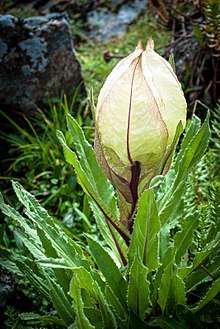Saussurea obvallata
Saussurea obvallata is a species of flowering plant in the Asteraceae. It is native to the Himalayas, Himachal Pradesh and Uttarakhand, India, Mongolian, northern Burma and southwest China. In the Himalayas, it is found at an altitude of around 4500 m.[2] It is the state flower of Uttarakhand.[3] Saussurea obvallata is a perennial growing to 0.3 m (1 ft). The flowers are hermaphrodite (have both male and female organs) and are pollinated by insects. Flowers bloom in mid-monsoon (July–August) amongst the rocks and grasses of the hillside at an altitudinal range of 3000–4800 m. Flower heads are purple, hidden from view in layers of yellowish-green papery bracts, which provide protection from the cold mountain environment. The flowers can be seen till mid-October, after which the plant perishes, becoming visible again in April.[4] Local names of this flower are Brahma Kamal, Kon , Kapfu and vansembruu.
| Saussurea obvallata | |
|---|---|
 | |
| Scientific classification | |
| Kingdom: | |
| (unranked): | |
| (unranked): | |
| (unranked): | |
| Order: | |
| Family: | |
| Tribe: | |
| Genus: | |
| Species: | S. obvallata |
| Binomial name | |
| Saussurea obvallata | |
Confusion about the Brahma Kamal flower
In Hindu drawings Brahma is seen sitting on a pink flower that resembles a lotus (Sanskrit: कमल), which is India's national flower. Hence, people claim that the pink flower of Nelumbo nucifera is the Brahma Kamal. However others claim that the flower on which he is sitting, resembles a lotus sprouted from the navel of Lord Vishnu. The flower which Brahma is holds in one of his four hands, a white flower resembling Saussurea obvallata is the Brahma Kamal. There are people who claim that the flower of Epiphyllum oxypetalum, the orchid cactus, which blooms at night, is the Brahma Kamal. Some North Indians claim that the flower of Saussurea obvallata is the Brahma Kamal.
Brahma Kamal in Hindu epics
The Lotus of Brahma: The name of this magical flower can be translated to mean, 'The Lotus of Brahma'. Lord Brahma, the creator of the Universe, is always depicted as sitting on a huge lotus and holding one in his hand. Another name for Lord Brahma is Kanja or the one born out of the water. So, schools of thought say that Brahma was born from the navel of Lord Vishnu while others say that he was born from a huge white lotus that we call the Brahma Kamal.
The Life Giving Lotus: The story of the birth of Ganesha is a popular one. On Parvati's request Brahma created Brahma Kamal, with whose help Shiva placed the head of an elephant on to the body of Ganesha. When Shiva attached the head of an elephant on Ganesha' s body, he was bathed with water that was sprinkled from a Brahma Kamal. That is why this lotus is given the status of a life-restoring flower of the gods. To evaluate it in terms of modern science, this flower has many medicinal properties.
The Golden Lotus: When the Pandavas were in exile in the forests, Draupadi accompanied them. She was constantly tormented by painful memories of her insult in the Kaurava court. The hardships of a forest life also took its toll on her. One evening she saw a beautiful lotus float away in the stream. After she saw this 'golden' lotus bloom, she felt a strange happiness that was almost spiritual. But the lotus withered as quickly as it had bloomed. Draupadi sent her most devoted husband Bhima to look for it and on his quest for the flower he met Hanuman (Bhima's elder brother). As a lotus is usually pink, 'golden' may mean a shimmering 'white'. This story too is a reference to this mysterious flower. Wish Fulfilling: It is long held belief that anybody who sees this rare flower blooming will have all his or her wishes fulfilled. It is not easy to watch it bloom because it blooms in the late evening and stays only for a couple of hours.
Similarly in Ramayana when the Sanjivani herb was administered to Lakshmana, he miraculously revived. In celebration, God showered flowers from heaven, which fell to the earth and took root in the Valley of Flowers. So it is called Brahma Kamal.
Culinary use
Found in the region of the Himalayas, Brahma Kamal is considered a medicinal herb in Tibetan medicine, where it is named ཤཟའ བདྭད མཤ དཤྭ (Sah-du Goh-ghoo). It is used to treat urogenital disorders, liver infections, sexually transmitted diseases, bone pains, and cold and cough. It has a bitter taste and the entire plant is used. The plant is endangered because people cut it down for their own use.
References
- "Saussurea obvallata (DC.) Edgew". The Plant List. Retrieved 6 August 2013.
- "Saussurea obvallata - Brahma Kamal". flowersofindia.net. 2012. Retrieved 8 October 2012.
Brahma Kamal, the much reverred flower of the Himalayas, is an excellent example of plant life at the upper limit of high mountains (3,000-4,600 m).
- "Uttarakhand State Signs | Uttarakhand State Animal | Uttarakhand State Bird | Uttarakhand State Flower | Uttarakhand State Tree". uttaraguide.com. 2012. Archived from the original on 7 November 2012. Retrieved 8 October 2012.
State Flower : Brahm Kamal
- https://www.academia.edu/3450091/Saussurea_obvallata_Brahmakamal_
External links
| Wikimedia Commons has media related to Saussurea obvallata. |